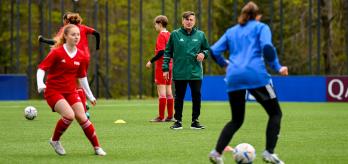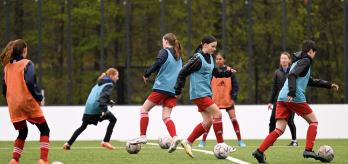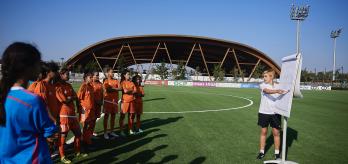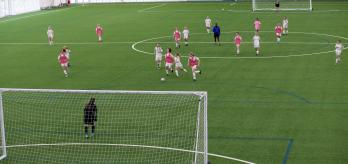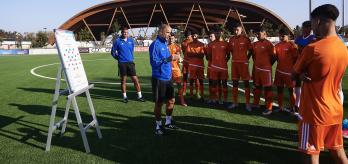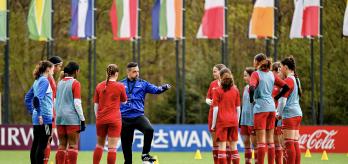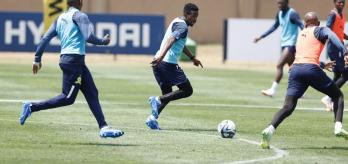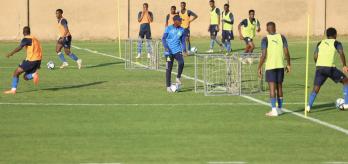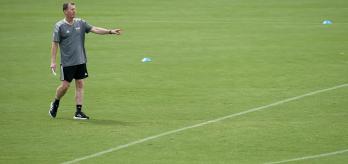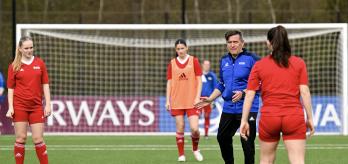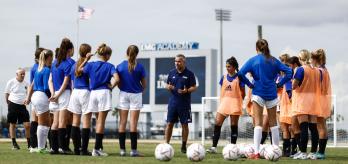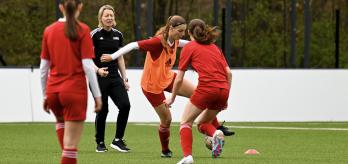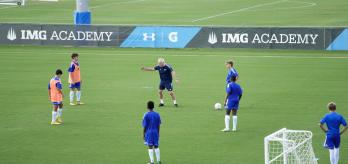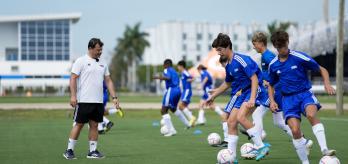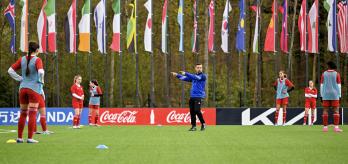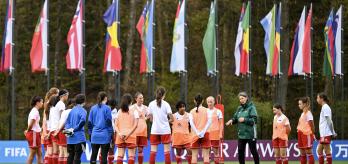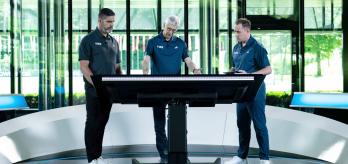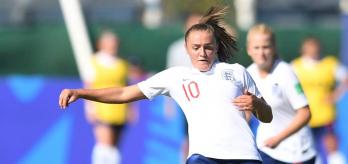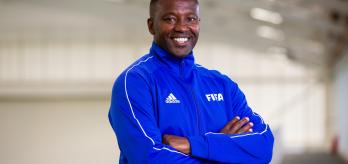Adopting the correct body orientation and performing short, sharp movements allows players to receive passes where they want them to be played, promotes close control and enables players to spin away from opposing players who may be putting them under pressure. These skills can also help players to play key passes and finish moves more efficiently.
In this session, FIFA Women’s Football Technical Expert and head coach of FC Zürich Women Jacqueline Dünker delivers a series of exercises that focus on directional control. The session, which involves a group of young girls, starts with a warm-up that is designed to activate all parts of the player’s body in preparation for the following exercises. The warm-up leads into three exercises that are performed in a reduced-sized playing area and allow players to work on body orientation and close control in a range of scenarios.
Session overview
Key coaching points
-
A receiving player’s body orientation signals where they wish for the pass to be played and determines their ability to keep the ball under close control.
-
When the receiving player opens their body in a certain direction, it signals to their team-mates to pass to their left or right foot and whether they wish to receive the ball to feet or into their path.
-
If the pass is inaccurate, short explosive movements involving quick footwork enable the receiving player to adjust their position quickly.
-
It is important that players are aware of their body orientation and movement to allow them to move in the direction they wish to go.
-
If players are stationary and wish to turn quickly, they may not be able to generate the speed or possesses the efficiency to do so without losing the ball.
Warm-up
Dribbling and passing
The warm-up is designed to activate all parts of the player’s body in preparation for the upcoming exercises and should be performed at a low level of intensity. The emphasis is on close control, passing and receiving, spatial awareness and shifting the ball into space.
-
Use the centre circle or mark out a 10-metre diameter circle.
-
Split the group into two teams of 8.
-
Give each player a ball.
-
Position all players inside the circle.
-
The players dribble the ball inside the circle while avoiding bumping into one another.
-
The coach calls out a body part, and the players must stop the ball and touch it with the relevant body part.
-
For example, if the coach shouts “left knee”, the players must touch the ball with their left knee.
-
The coach should use a variety of body parts (chest, knees, elbows, stomach, head, nose, etc.)
Variation 1
-
The coach calls out a series of body parts in succession, e.g. “left knee, right knee, chest”.
-
The players must touch the ball with these body parts in the same order in which the coach called them out.
Variation 2
-
Players exchange balls as they dribble around the circle.
-
Close control and the ability to shift the ball quickly onto either foot helps players to avoid bumping into one another.
-
Players should constantly check their shoulders and the space into which they intend to move.
-
By communicating to which foot they wish to receive the pass, players can help to avoid balls colliding with each other.
Passing and receiving
This second part of the warm-up works on spatial awareness when passing and receiving the ball. By adapting their body orientation, the receiver of the pass can signal to the passer where they wish to receive the pass, open up passing lanes and create space to turn into once they have received the ball.
-
Use the centre circle or mark out a 10-metre diameter circle.
-
Split the group into two teams of 8.
-
Position the blue players around the edge of the circle, with an equal distance between each player.
-
Place the orange players inside the circle.
-
Give each of the orange players a ball.
-
The orange players dribble freely inside the circle.
-
When an orange player is within 5m of a blue player, they pass the ball out of the circle to that player.
-
The blue player returns the pass to the orange player, who receives the ball on the turn and moves away.
-
The orange player then repeats this sequence with another blue player.
-
Instead of exchanging passes once, players perform a passing sequence involving four passes.
-
After playing the first pass to the blue player, the orange player takes a small step to the side to open up an “exit route”.
-
After receiving the return pass from the blue player, the orange player plays the ball back to them before moving into the space they created in readiness to receive the ball on the move.
-
After receiving the second return pass, the orange player dribbles into the space and looks for another blue player to combine with.
-
By opening up their body, the receiving player signals where they wish to receive the ball and can create space to move into.
-
It is vital that orange-team players check their shoulders and are on their toes when waiting to receive the return pass, as this will allow them to control and shift the ball with confidence.
-
Asking orange-team players to take a step to the side after they have played the first pass is designed to simulate the action of drawing in a defender. This movement creates space for the player to drive into after they have received the return pass.
Part 1: Control and shoot
This exercise aims to improve players’ efficiency when receiving the ball to finish on goal. Adopting an open body orientation and retaining close control helps players to adjust more quickly to set up a shot, whilst curving their runs allows players to receive passes away from defenders and into space, thereby offering them a clearer sight of goal.
-
Mark out a 30x20m playing area.
-
Place a full-size goal at either end of the playing area.
-
Place a goalkeeper in each goal.
-
Split the group into two teams (blues and oranges).
-
Place two cones in the middle of the playing area and 5m apart.
-
Position a blue player at the right-sided cone.
-
Position an orange player at the left-sided cone.
-
Position the remaining blue players to the left side of the playing area and give them a number of balls.
-
Position the remaining orange players to the right side of the playing area and give them a number of balls.
-
The sequence begins on the coach’s signal.
-
On the coach’s signal, the 2 players at the central cones curve their run around the right side of the other cone to where they are stationed.
-
Shortly before they reach this cone, a team-mate positioned at the side of the playing area plays a pass into their path.
-
The player controls the ball with their first touch and shoots on goal with their second touch.
-
The outside player who played the pass then takes up a position at the central cones.
-
The player who shot on goal joins the back of their team’s queue outside the playing area.
-
The sequence is repeated.
-
Create a competition between the teams, with one point awarded for each goal.
-
Encourage players to control the ball with their left foot and shoot with their right to ensure that they perform short, explosive movements and keep the ball under close control.
-
Being on their toes and timing their movements allows players to adjust their feet more quickly in readiness to receive a pass.
-
When curving their runs, players should perform explosive movements, which are effective when it comes to evading the attentions of defenders.
-
Players should move onto the pass rather than receiving in a stationary position, as this helps them to generate more power and take a firmer first touch to set up the shot on goal.
Part 2: passing into a 2v2 game
The focus in this exercise is on passing, receiving the ball under pressure and performing quick movements to beat the opposing team. Receiving players should focus on their body orientation at all times, as this will help them to take a quick touch and play a pass.
-
Mark out a 30x20m playing area.
-
Place a full-size goal at either end of the playing area.
-
Position a goalkeeper in each goal.
-
Place two mini-goals 10m behind one of the full-size goals (one mini-goal to the left of the goal and one to the right).
-
Split the group into two teams (blues and oranges.)
-
Position a player from each team in the middle of the playing area.
-
Position a player from each team at the cones placed in either corner of the playing area closest to the mini-goals.
-
Line the rest of the players on each team up behind the mini-goal on the same side as their team-mate at the cone placed in corner of the playing area.
-
On the coach’s signal, a player positioned behind the mini-goal plays a pass into their team-mate stationed at the cone placed at the corner of the playing area.
-
This player controls the ball with their first touch and passes it into the mini-goal with their second touch.
-
The player who played the pass into the mini-goals sprints to join their team-mate in the playing area to create a 2v2 scenario.
-
The coach plays a ball to whichever player passed the ball into the mini-goal first. If neither player passes the ball into the mini-goals, the coach plays a high ball into the middle of the playing area.
-
The in-possession team combine and try to score in the full-size goal furthest away from the mini-goals.
-
If the defending team win the ball, they can try to score in the other full-size goal.
-
The sequence ends when a goal is scored or the ball is put out of play.
-
Players then rotate positions by moving to the next station before the next sequence can begin. For example, the central player joins their team-mates in the queue behind the mini-goals and the player who played the initial pass takes up a position at the cone placed at the corner of the playing area.
-
The initial pass needs to be firm and accurate to allow the receiving player to pass the ball into the mini-goal before the opposition do so.
-
Being on their toes and opening up their body helps the receiver to take a touch and play a quick, accurate pass into the mini-goal.
-
Players in the middle of the playing area must be on their toes and prepared to adjust quickly to either defend or attack.
-
If players are taking too long to finish on goal in the 2v2 scenario, encourage them by counting down from five.
-
Spatial awareness is a key consideration for all players, as it helps them to create passing lanes and receive the ball in areas in which they can move freely.
Part 3: small-sided game
This final exercise gives players the opportunity to practise receiving the ball under pressure in a game-like scenario. Players must ensure that they take a good first touch that sets them up to either play a pass, take a shot on goal or shift the ball into space to overcome the pressure.
-
Mark out a 30x20m playing area.
-
Place a full-size goal at either end of the playing area.
-
Position a goalkeeper in each goal.
-
Split the group into two teams (blues v. oranges).
-
Position players from both teams either side of their respective goals.
-
The coach calls out two numbers in quick succession.
-
The first number represents the number of blue players that can enter the playing area.
-
The second number represents the number of orange players that can enter the playing area.
-
The coach passes the ball to the team with fewer players.
-
This team combine and try to score in the opposing goal.
-
If the defending team win the ball, they can counter-attack and try to score in the opposing goal.
-
If the coach calls out an even number of players for both teams, the coach decides which team to play the ball to.
-
If players are taking too long to finish on goal in the 2v2 scenario, encourage them by counting down from ten.
-
The sequence ends when a goal is scored or the ball is put out of play.
-
The coach plays the ball to the team with the most players.
-
When receiving the ball and where possible, players must ensure that their first touch takes them towards the opposing goal and try to pass or shoot with their second touch.
-
Quickly shifting their body orientation and feet allows players to adjust to different scenarios and passing situations.
-
Players should focus on making good initial contact with the ball, as this can help to set up a key pass or shot.
-
Players should open up their bodies to signal where they wish to receive the pass.
-
When receiving a pass, a player’s body orientation should reflect the direction in which they wish to move.
















